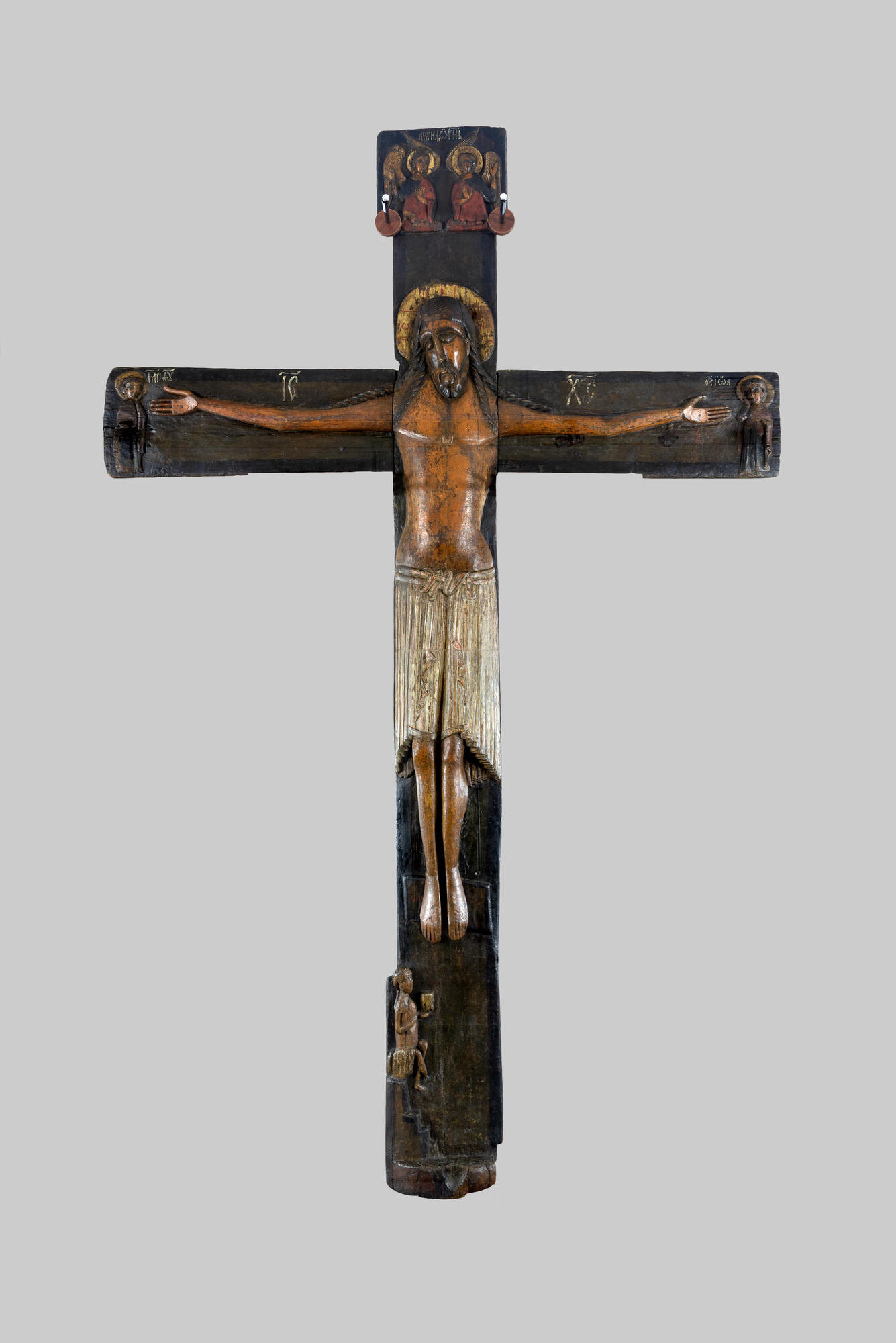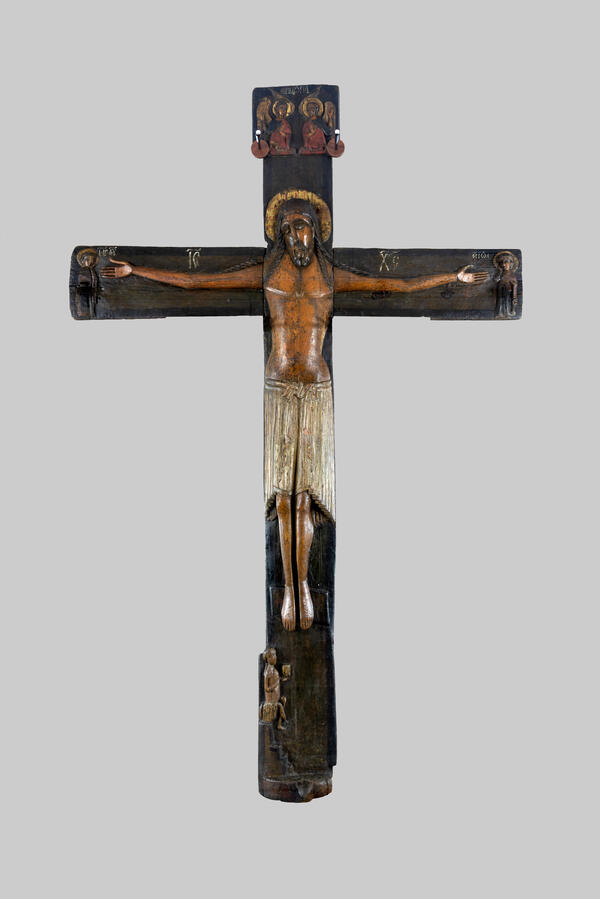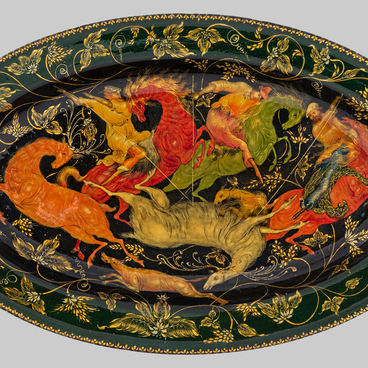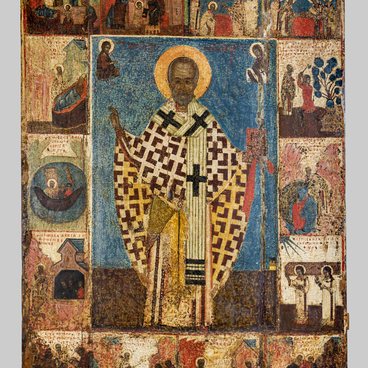The 17th-century wayside Crucifix has become the centerpiece of the exhibition in the Old Russian Art hall. The museum received it from an old-rite church in the town of IvAnovo. The cross consists of two beams. They are made of two solid boards, with figures carved on their flat surface.
The unknown craftsman gave the body of Jesus elongated proportions. The author did not focus on the physical suffering of the Savior. Small images of the Virgin Mary and John the Theologian are carved near the palms of Jesus. The figures are full-length and are located on the horizontal beam. They are holding their faces in their hands in grief.
Two angels can be seen over the head of the Savior. They are accompanied by the inscription, ‘Angels of Fire.’ The author depicted a half-naked figure at the base of the cross instead of a symbol of Golgotha. Some sources say that this is Adam, while others claim it to be Eve. The progenitor is holding a cup in their hand into which the blood from Jesus’s wound is dripping. It is believed that after his death, Jesus descended into hell and rescued the souls of the righteous, and with them Adam and Eve. They were saved because he atoned for their original sin with his blood. On the 17th century Crucifix, the way out of hell is symbolized by carved steps, with the progenitor standing on the fourth and highest step. The three-dimensional figures are painted with tempera.
On the back of the cross we can see the remains of a painting with the Instruments of the Passion of Jesus. The Passion cycle was especially popular in Western art: it tells about the objects that were used to torture Jesus. In Russia, such symbols became widespread in the second half of the 17th century. Some of the Instruments of the Passion are clearly indicated in the Gospels, while others are mentioned in apocryphal legends. On the horizontal beam, we can distinctively see four forged nails, a ladder (used to help nail the body), and pincers (used to remove the body from the cross).
A complex image of Golgotha, a symbol of the mountain where the Savior was crucified, is depicted on the vertical beam. Above it is a pillar with reeds and sponges on its sides. The Evangelists mentioned how the soldiers tied a sponge soaked in vinegar to a reed and offered it to Jesus. There is an image of a rooster on the column. It symbolizes the denial of the Apostle Peter. “Truly, I tell you, this very night, before the rooster crows, you will deny me three times, ” said the Savior to his follower. Above the pillar the author depicted a hand: a symbol of desecration and a blow to Jesus Christ on his cheek.
The unknown craftsman gave the body of Jesus elongated proportions. The author did not focus on the physical suffering of the Savior. Small images of the Virgin Mary and John the Theologian are carved near the palms of Jesus. The figures are full-length and are located on the horizontal beam. They are holding their faces in their hands in grief.
Two angels can be seen over the head of the Savior. They are accompanied by the inscription, ‘Angels of Fire.’ The author depicted a half-naked figure at the base of the cross instead of a symbol of Golgotha. Some sources say that this is Adam, while others claim it to be Eve. The progenitor is holding a cup in their hand into which the blood from Jesus’s wound is dripping. It is believed that after his death, Jesus descended into hell and rescued the souls of the righteous, and with them Adam and Eve. They were saved because he atoned for their original sin with his blood. On the 17th century Crucifix, the way out of hell is symbolized by carved steps, with the progenitor standing on the fourth and highest step. The three-dimensional figures are painted with tempera.
On the back of the cross we can see the remains of a painting with the Instruments of the Passion of Jesus. The Passion cycle was especially popular in Western art: it tells about the objects that were used to torture Jesus. In Russia, such symbols became widespread in the second half of the 17th century. Some of the Instruments of the Passion are clearly indicated in the Gospels, while others are mentioned in apocryphal legends. On the horizontal beam, we can distinctively see four forged nails, a ladder (used to help nail the body), and pincers (used to remove the body from the cross).
A complex image of Golgotha, a symbol of the mountain where the Savior was crucified, is depicted on the vertical beam. Above it is a pillar with reeds and sponges on its sides. The Evangelists mentioned how the soldiers tied a sponge soaked in vinegar to a reed and offered it to Jesus. There is an image of a rooster on the column. It symbolizes the denial of the Apostle Peter. “Truly, I tell you, this very night, before the rooster crows, you will deny me three times, ” said the Savior to his follower. Above the pillar the author depicted a hand: a symbol of desecration and a blow to Jesus Christ on his cheek.



